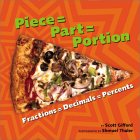|
Buy from Amazon.com
Rate this Book Sonderbooks 67 Previous Book Next Book Nonfiction Fiction Young Adult Fiction Children's Nonfiction Mathematics Previous Book Next Book Children's Fiction Picture Books 2005 Stand-outs 2004 Stand-outs 2003 Stand-outs 2002 Stand-outs 2001 Stand-outs Five-Star Books Four-Star Books Old Favorites Back Issues List of Reviews by Title List of Reviews by Author Why Read? Children and Books Links For Book Lovers Book Discussion Forum About Me Contact Me Subscribe Make a Donation I don't review books I don't like! *****= An all-time favorite |

***Piece = Part = PortionFractions = Decimals = Percentsby Scott GiffordPhotographs by Shmuel ThalerReviewed November 24, 2003.
Tricycle Press (Ten Speed Press), Berkeley, California, 2003. 32 pages. Available at Sembach Library (J 513.26 GIF). I wish this book had been available back when I was teaching Probability and Statistics. Every semester, there would be at least a few students who had trouble with the basic concept that fractions, decimals and percents are simply different ways of saying the same thing. Although college students might be insulted to be asked to look at a picture book, perhaps this book will explain the concept to kids before they become college students. The presentation is simply and beautifully done. At the front, there’s a page explaining how to convert between fractions and decimals and percents. After that, each two-page spread shows a picture of part of something, with text explaining what it is as a fraction, a decimal and a percent. For example: 1/12 of a dozen eggs .08 8% 1/8 of a pie .125 12.5% I have a couple of minor quibbles. Nothing is said about rounding, so some repeating decimals are presented as if they simply stop. 1/3 is said to be 33%. Worse, 2/3 is said to be 66%, when it’s closer to 67%. Still, this approach kept the book simpler. A math teacher might want to have kids find out what repeating decimal is behind 1/11, for example. Another quibble is that I don’t like it when teachers tell students to convert a fraction to a decimal by multiplying times 100, then sticking on a percent sign. Tell them to multiply times 100%. Since 100% equals one, and multiplying times one doesn’t ever change a number’s value, this makes perfect sense, and is not a random rule to remember. I would argue that .50 x 100 does NOT equal 50%, but 50. However, .50 x 100% does equal 50%, so I wish the author had written it that way. Those are tiny complaints. Overall, I’m thrilled that someone wrote this book, and I’m going to make sure that my fourth-grader takes a good look at it. It simply and effectively presents an important mathematical concept that many people have trouble with. Copyright © 2003 Sondra Eklund. All
rights reserved. |